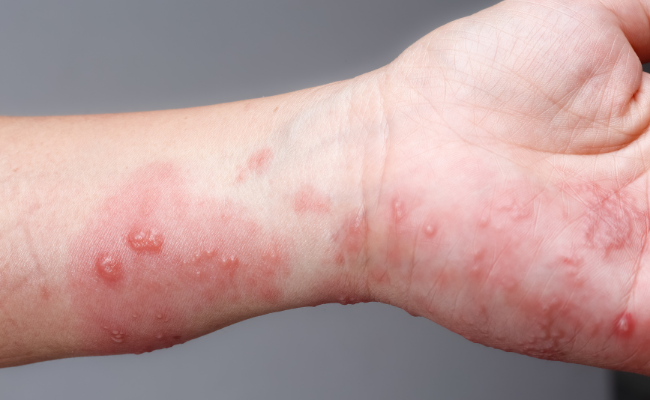How to Treat Scabies?
- December 01, 2023
- No Comments

What is Scabies?
Scabies, a parasitic infestation caused by the Sarcoptes scabiei mite, occurs when the mite burrows into the skin, creating tunnels and laying eggs. This triggers an immune response, leading to intense itching and a distinctive rash. The nearly invisible mites are primarily transmitted through skin-to-skin contact, with indirect transmission possible through infested clothing and bedding. The hallmark symptom is a persistent itch that intensifies at night, causing sleep disturbances and considerable distress. In close living quarters, scabies is highly contagious, necessitating simultaneous examination and treatment of family members and close contacts if one individual is diagnosed.
Commonly known as sarcoptic mange, scabies is more prevalent in tropical regions and densely populated areas. While the condition is a global concern, its colloquial term emphasizes its connection to animals. Animals can contract scabies from a slightly different species of mites, but these mites affecting pets typically cannot adapt to human hosts. However, individuals may experience some form of reaction when in contact with mites from their pets.
Why is Scabies a Concern?
Beyond the immediate discomfort of incessant itching, scabies raises concerns due to its potential complications if left untreated. Scratching the affected areas can break the skin, providing an entry point for bacteria and leading to secondary bacterial infections. These infections can exacerbate the symptoms and complicate the treatment process. Moreover, the relentless itching associated with scabies can significantly impact an individual's quality of life, causing sleep disturbances, heightened stress, and anxiety.
How Does Scabies Spread?
Understanding the mode of transmission is crucial in preventing the spread of scabies. The mites responsible for scabies infestations are highly contagious, and their spread is facilitated through direct and prolonged skin contact. However, scabies can also be transmitted indirectly through infested clothing, bedding, or furniture. The risk of transmission is elevated in crowded living conditions, such as those found in nursing homes, prisons, or other institutional settings.
Treatment Solutions for Scabies
Effectively treating scabies requires a multi-faceted approach that targets both the mites and their eggs. The following are key treatment solutions:
- Topical Scabicides: Permethrin and ivermectin are commonly prescribed topical scabicides. These creams or lotions contain insecticides that kill the mites and their eggs.
- Oral Medications: In severe cases, oral medications like ivermectin may be recommended to ensure thorough eradication of the mites.
- Antihistamines: Over-the-counter antihistamines can be used to alleviate the intense itching associated with scabies. While these medications do not treat the infestation itself, they provide much-needed relief from the symptoms.
- Steroid Creams: Corticosteroid creams may be prescribed to reduce inflammation and ease itching. These creams are particularly useful during the initial phase of treatment when itching is at its peak.
- Hygiene Practices: Good hygiene practices play a crucial role in preventing the spread of scabies. Regularly washing clothes, bedding, and personal items in hot water and vacuuming living spaces can help eliminate any lingering mites.
- Isolation and Avoidance: Infected individuals should avoid close contact with others until the treatment is complete. Sexual partners and household members may also need treatment, even if they are asymptomatic, to prevent further transmission.
Benefits of Prompt Treatment
- Faster Relief from Symptoms: Initiating treatment promptly ensures quicker relief from the incessant itching and discomfort associated with scabies. Rapid relief enhances the overall well-being of affected individuals.
- Prevention of Complications: Prompt treatment helps prevent complications such as bacterial infections resulting from scratching. By minimizing the risk of secondary health issues, individuals can recover more swiftly and with fewer complications.
- Prevention of Spread: Treating scabies promptly is crucial in preventing its spread to others. Early intervention breaks the cycle of transmission, especially in close-knit communities, reducing the overall impact of the infestation.
- Improved Quality of Life: Effective treatment translates to an improved quality of life for individuals suffering from scabies. Eliminating the infestation brings an end to the constant itching and restores a sense of normalcy to daily life.
- Reduction in Healthcare Costs: Early treatment can lead to cost savings in healthcare. Preventing complications and the need for more extensive medical interventions contributes to overall healthcare efficiency and reduces the economic burden on both individuals and healthcare systems.
Comments (0)